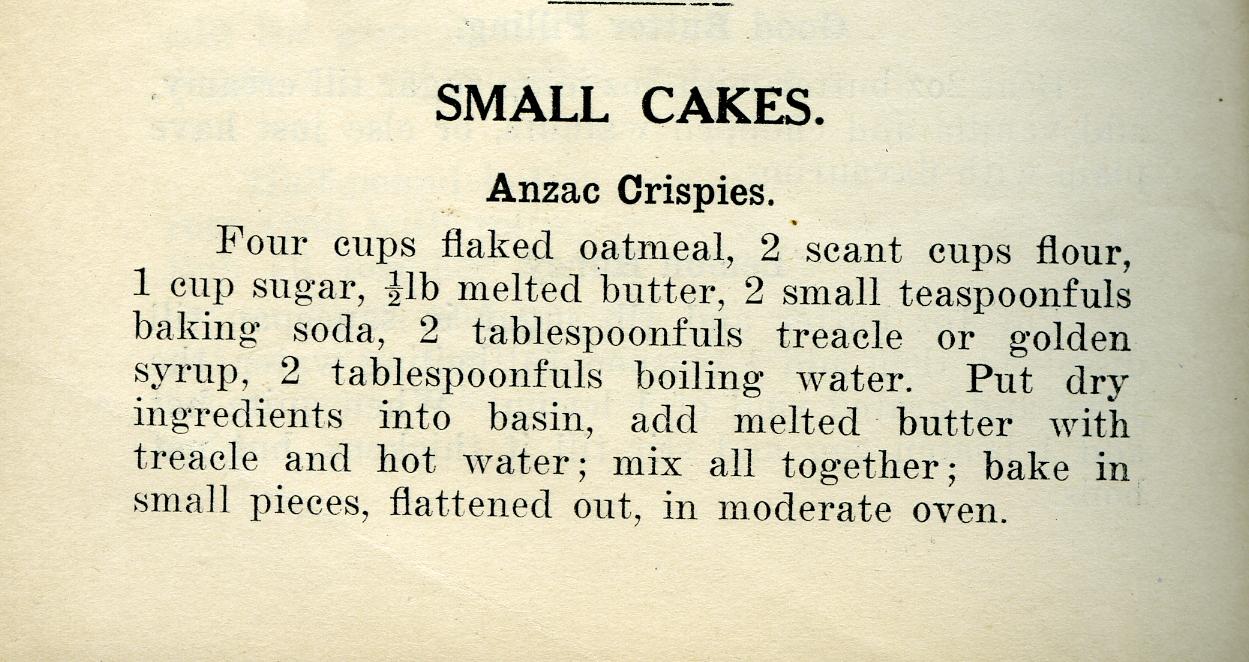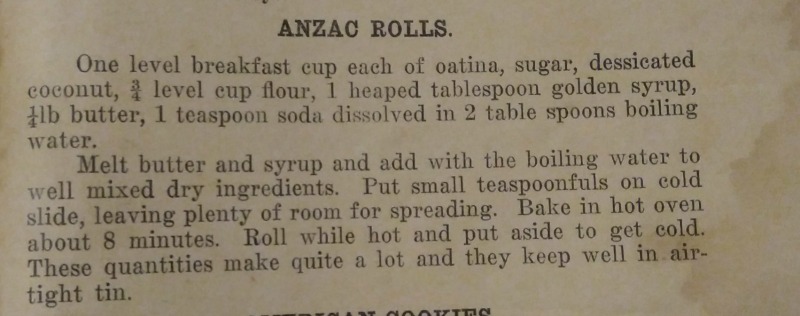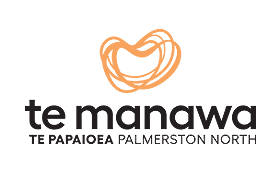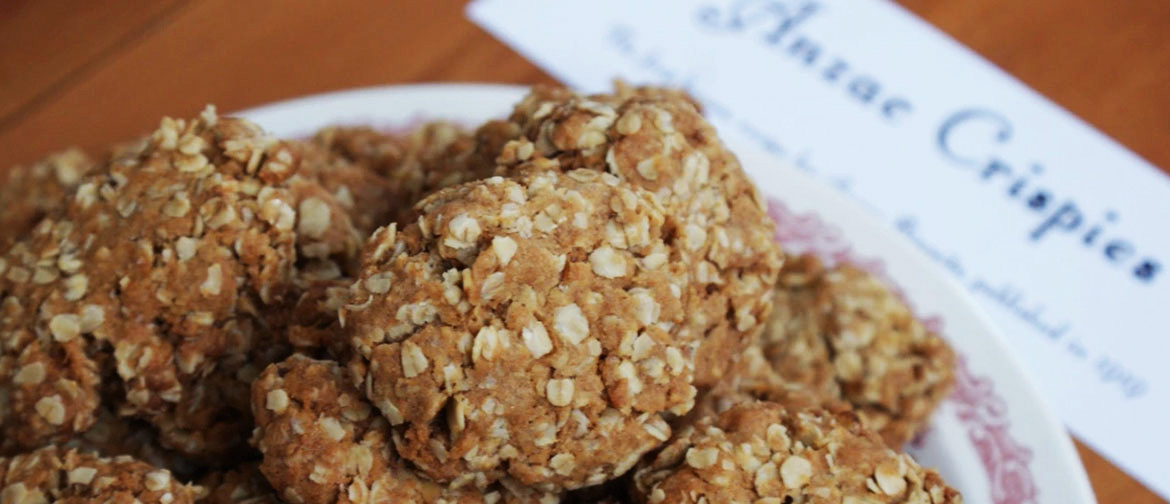Australia and New Zealand celebrate our day of remembrance, Anzac Day, on 25 April. The day commemorates Australians and New Zealanders killed in war, and honours returned servicemen and women. And, like any worthy national day, Anzac Day has its own namesake food: the Anzac biscuit. These biscuits are beloved in both nations, and range from dense and chewy to crisp and crumbly. There are hundreds of recipes to be found, but they all have the same key ingredients: rolled oats, golden syrup, coconut and butter. How did such a simple biscuit become so incredibly popular and so strongly associated with our day of remembrance?
There is an enduring myth that the biscuits were sent to loved ones on the front, but the truth is that few of what we know as Anzac biscuits were actually sent overseas. This isn’t for lack of love but logistics: the biscuits needed to keep well on a long joinery overseas, and their arrival at the front whole and unharmed was unlikely. Non-perishable food, such as jam, was infinitely more likely to survive and provide that sweet taste of home.
That’s not to say that no biscuits were sent at all: Ngā Taonga, New Zealand’s audiovisual archive, holds an audio interview from 1965 with 100 year old Helena Marion Barnard, who baked tonnes of gingernut biscuits – literally – and popularised a particular recipe for the biscuits. She received the British Empire Medal for her efforts.
On a less tasty note, there were biscuits known at times to the soldiers as Anzac biscuits, but they were hated hardtack biscuits: a part of their rations and reputably tooth-breakingly hard. There are some reports men even ground them down to make porridge. Such a food isn’t going to make its way into the national cuisine.
Instead, Anzac biscuits were made and eaten in New Zealand and Australia, and often sold as a fundraiser at galas and fairs. The first published reference to what became an ‘Anzac biscuit’ can be found in the 8th edition of the St Andrew’s Cookery Book, published in Dunedin in 1919. The recipe for ‘Anzac Crispies’ was found by Otago University’s Professor Helen Leach, to whom I am indebted for sharing her research and findings to help shape this post. However, it wasn’t the first instance of the name Anzac being linked to a food. That honour goes to the 1915 St. Andrew’s Cookery Book, 7th ed., which included a list of recipes advertising Waitaki Butter, and was the last of a list of five recipes. This was a ‘recipe’ for Anzac Cakes, and Professor Leach told me that “it looks as though it would have made a plain fruit cake, but since the title of the recipe says cakes plural we must assume the mixture was divided between muffin tins or simply spooned on to the baking tray. Without egg or other liquid it would have made a firm cake or cakes”. The Anzac Cakes recipe offers no method: just ingredients. The recipe (kindly transcribed for me by Professor Leach, and included below) bears no resemblance to the Anzac Crispies recipe that appeared in the following edition in 1919.
Professor Leach wisely pointed out that when the history of a recipe is being compared, it is important to take into consideration both the name and the ingredients to do a comprehensive cross-referencing of a food’s past. The 1915 recipe may have been the first known recipe to have Anzac in the name, but it is not an Anzac biscuit as Australians and New Zealanders would commonly accept as an Anzac Biscuit today. A similar situation occurs from The War Chest Cookery Book, published in Sydney, Australia in 1917: Anzac was in the name but had entirely the wrong ingredients. Not an oat in sight! The 1919 Crispie recipe is the first biscuit-like name with the right combination of ingredients, and is followed with a published recipe for Anzac Biscuits in the Melbourne Argus, Australia in 1921.
This original 1919 recipe shows the evolution of the biscuit: being a mix of oats, flour, sugar, butter, treacle or golden syrup, and baking soda dissolved in boiling water. The recipe has evolved and today always includes coconut, and sometimes raisins. The RSA in New Zealand sell the biscuits as a fundraiser, and have introduced a chocolate drizzle and a cranberry version: no doubt tasty and continues the tradition of food evolving over the years.
As a fun digression (and another look into New Zealand English, our food culture and science) the baking soda and water that is added to the mix of melted golden syrup and butter produces a chemical reaction between the soda and acidic syrup, forming an unstable carbonic acid, which breaks down into carbon dioxide. The heat speeds up the reaction, and causes the mixture to increase in size, making it much easier to spread amongst the dry ingredients. The same reaction is used to make the sweet known as honeycomb toffee – called hokey pokey in New Zealand.
An early recipe for Hokey Pokey can be found in Wellington’s Evening Post from 1927, and the word has permeated our edible culture. Hokey Pokey is a popular kiwi ice-cream flavour with little nuggets of honeycomb toffee suspended in vanilla ice cream, that apparently has been in New Zealand’s freezers since the 1940s. The word Hokey Pokey actually already had strong links to ice cream, having been a slang term in parts of America and the United Kingdom during the 19th and early 20th centuries, and ice cream street vendors were known as “hokey-pokey” men. The question is, what was named first: the toffee or the ice cream? My bet’s on the ice cream, which may have lent its name to the toffee as the flavour grew in popularity here in New Zealand.
But back to the biscuit in hand. Anzac biscuits as we know them have a sweet, toffee-like flavour, balanced by the starch of the oats and mellowed by the coconut. So let’s have a look at the recipes to see their evolution. I list here a range of recipes from the first suggestion of Anzac with a dish, to the first proper recipe progressing to modern.
St Andrew’s Cookbook, Dunedin, New Zealand; 1915
“Anzac Cakes
Ingredients: One pound flour, 1/2 lb sugar, 6 oz Waitaki Butter, 1 teaspoonful baking powder, 1/2 lb fruit.”
St Andrew’s Cookbook, Dunedin, New Zealand; 1919
The first Anzac ‘biscuit’ recipe, found by Emeritus Professor Helen Leach

1933 Calender Cook Book, Country Women’s Association, NSW, Australia
“2 cups rolled oats, ½ cup flour, 1 small cup sugar, ¼ cup butter, 1 tablesp. golden syrup, 1 teasp.carb.soda, 3 tablesp.boiling water. Put rolled oats and flour into basin: melt butter and sugar together and mix well with flour and oats; dissolve syrup in water and stir in soda till it foams well, then add to other ingredients and mix well. Put in 1/2 teaspoon drops on a cold, well greased slide and bake in a very a very slow oven, as they burn very easily. It is necessary to put them fairly far apart on the slide as they spread.
– Miss Murray, Manildra Branch”
The Cookery Book of the N.Z. Women’s Institutes, Levin, New Zealand; 1937
An unusual iteration of the Anzac biscuit from 1937, with the biscuits rolled into spiralled tubes.

The Aunt Daisy Cookbook, Auckland, New Zealand; 1982 (first published 1968)
Anzac Biscuits
Melt 1/4lb butter with 1 tablespoon golden syrup. Add 1 teaspoon baking soda dissolved in 2 tablespoons boiling water. Then add following: 1 cup sugar, 1 cup coconut, 1 cup wheatmeal, 1 cup chopped walnuts, 3/4 cup flour. Take small teaspoonfuls and roll into small balls, then place on cold oven sheet, leaving space between each. Cook 1/2 hour in slow oven.”
New Zealand Women’s Weekly, digital, 2018
“1 cup flour
1 cup caster sugar
1 cup desiccated coconut
2 cups rolled oats
125g butter
2 tbsp golden syrup
1 tsp baking soda
3 tbsp boiling water
Heat oven to 180°C (160°C fan bake). Line two baking trays with nonstick baking paper. Place flour, caster sugar, coconut and oats in a bowl and stir to combine. Make a well in the centre.
Place butter and golden syrup in a saucepan to melt, or microwave in a bowl to melt. Dissolve baking soda in boiling water. Add melted ingredients and dissolved baking soda to dry ingredients and mix to combine.
Roll spoonfuls into balls and press onto prepared baking trays, allowing space for biscuits to spread while cooking.
Bake for 15 minutes or until firm and golden brown. Remove to a wire rack to cool, and enjoy!”
References
Hokey Pokey, The Evening Post,. Papers past, accessed 17/4/18.
Leach, Helen. Department of Anthropology and Archaeology, Otago University.
The Real ANZAC Biscuit Story, National Army Museum. Accessed 17/4/2018. www.armymuseum.co.nz/kiwis-at-war/did-you-know/the-anzac-biscuit
Traditional recipe. Country Women’s Association Exeter Branch, www.exetercwa.org/past-events/anzacblog/115-traditional-recipe
Was the “real” Anzac biscuit … a ginger nut? Nga Taonga, reviewed 17/4/2018. ngataonga.org.nz/blog/nz-history/was-the-real-anzac-biscuit-a-gingernut
General reading on Anzac Biscuits came from Allyson Gofton, jamieoliver.com, Fairfax media, Unibic, Auckland Council, and the old devil, wikipedia. Ice cream references from The National Library (search Hokey Pokey) and New Zealand Herald.
Read more heritage stories in the Te Manawa magazine. Read more of Juliet’s food writing at Zealandia’s Kitchen.




